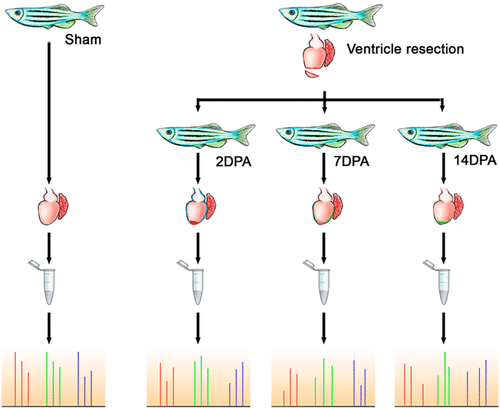当前位置:
X-MOL 学术
›
J. Proteome Res.
›
论文详情
Our official English website, www.x-mol.net, welcomes your feedback! (Note: you will need to create a separate account there.)
Dynamics of Zebrafish Heart Regeneration Using an HPLC–ESI–MS/MS Approach
Journal of Proteome Research ( IF 4.4 ) Pub Date : 2018-02-05 00:00:00 , DOI: 10.1021/acs.jproteome.7b00915 Danjun Ma 1 , Chengjian Tu 2 , Quanhu Sheng 3 , Yuxi Yang 4 , Zhisheng Kan 5 , Yan Guo 6 , Yu Shyr 3 , Ian C. Scott 7, 8 , Xin Lou 4
Journal of Proteome Research ( IF 4.4 ) Pub Date : 2018-02-05 00:00:00 , DOI: 10.1021/acs.jproteome.7b00915 Danjun Ma 1 , Chengjian Tu 2 , Quanhu Sheng 3 , Yuxi Yang 4 , Zhisheng Kan 5 , Yan Guo 6 , Yu Shyr 3 , Ian C. Scott 7, 8 , Xin Lou 4
Affiliation

|
Failure to properly repair damaged due to myocardial infarction is a major cause of heart failure. In contrast with adult mammals, zebrafish hearts show remarkable regenerative capabilities after substantial damage. To characterize protein dynamics during heart regeneration, we employed an HPLC–ESI–MS/MS (mass spectrometry) approach. Myocardium tissues were taken from sham-operated fish and ventricle-resected sample at three different time points (2, 7, and 14 days); dynamics of protein expression were analyzed by an ion-current-based quantitative platform. More than 2000 protein groups were quantified in all 16 experiments. Two hundred and nine heart-regeneration-related protein groups were quantified and clustered into six time-course patterns. Functional analysis indicated that multiple molecular function and metabolic pathways were involved in heart regeneration. Interestingly, Ingenuity Pathway Analysis revealed that P53 signaling was inhibited during the heart regeneration, which was further verified by real-time quantitative polymerase chain reaction (Q-PCR). In summary, we applied systematic proteomics analysis on regenerating zebrafish heart, uncovered the dynamics of regenerative genes expression and regulatory pathways, and provided invaluable insight into design regenerative-based strategies in human hearts.
中文翻译:

斑马鱼心脏再生动力学的HPLC-ESI-MS / MS方法
无法正确修复因心肌梗塞造成的损害是造成心力衰竭的主要原因。与成年哺乳动物相反,斑马鱼的心脏在受到实质性破坏后显示出显着的再生能力。为了表征心脏再生过程中的蛋白质动力学,我们采用了HPLC-ESI-MS / MS(质谱)方法。在三个不同的时间点(2、7和14天)从假手术的鱼和脑室切除的样本中获取心肌组织。通过基于离子电流的定量平台分析蛋白质表达的动力学。在所有16个实验中,对2000多个蛋白质组进行了定量。量化了299个与心脏再生相关的蛋白质组,并将其分为六个时程模式。功能分析表明,心脏再生涉及多种分子功能和代谢途径。有趣的是,Ingenuity Pathway Analysis发现P53信号在心脏再生过程中受到抑制,这通过实时定量聚合酶链反应(Q-PCR)进一步得到证实。总之,我们在斑马鱼心脏的再生中应用了系统的蛋白质组学分析,揭示了再生基因表达和调控途径的动力学,并为人类心脏中基于再生设计的策略提供了宝贵的见识。
更新日期:2018-02-06
中文翻译:

斑马鱼心脏再生动力学的HPLC-ESI-MS / MS方法
无法正确修复因心肌梗塞造成的损害是造成心力衰竭的主要原因。与成年哺乳动物相反,斑马鱼的心脏在受到实质性破坏后显示出显着的再生能力。为了表征心脏再生过程中的蛋白质动力学,我们采用了HPLC-ESI-MS / MS(质谱)方法。在三个不同的时间点(2、7和14天)从假手术的鱼和脑室切除的样本中获取心肌组织。通过基于离子电流的定量平台分析蛋白质表达的动力学。在所有16个实验中,对2000多个蛋白质组进行了定量。量化了299个与心脏再生相关的蛋白质组,并将其分为六个时程模式。功能分析表明,心脏再生涉及多种分子功能和代谢途径。有趣的是,Ingenuity Pathway Analysis发现P53信号在心脏再生过程中受到抑制,这通过实时定量聚合酶链反应(Q-PCR)进一步得到证实。总之,我们在斑马鱼心脏的再生中应用了系统的蛋白质组学分析,揭示了再生基因表达和调控途径的动力学,并为人类心脏中基于再生设计的策略提供了宝贵的见识。



























 京公网安备 11010802027423号
京公网安备 11010802027423号